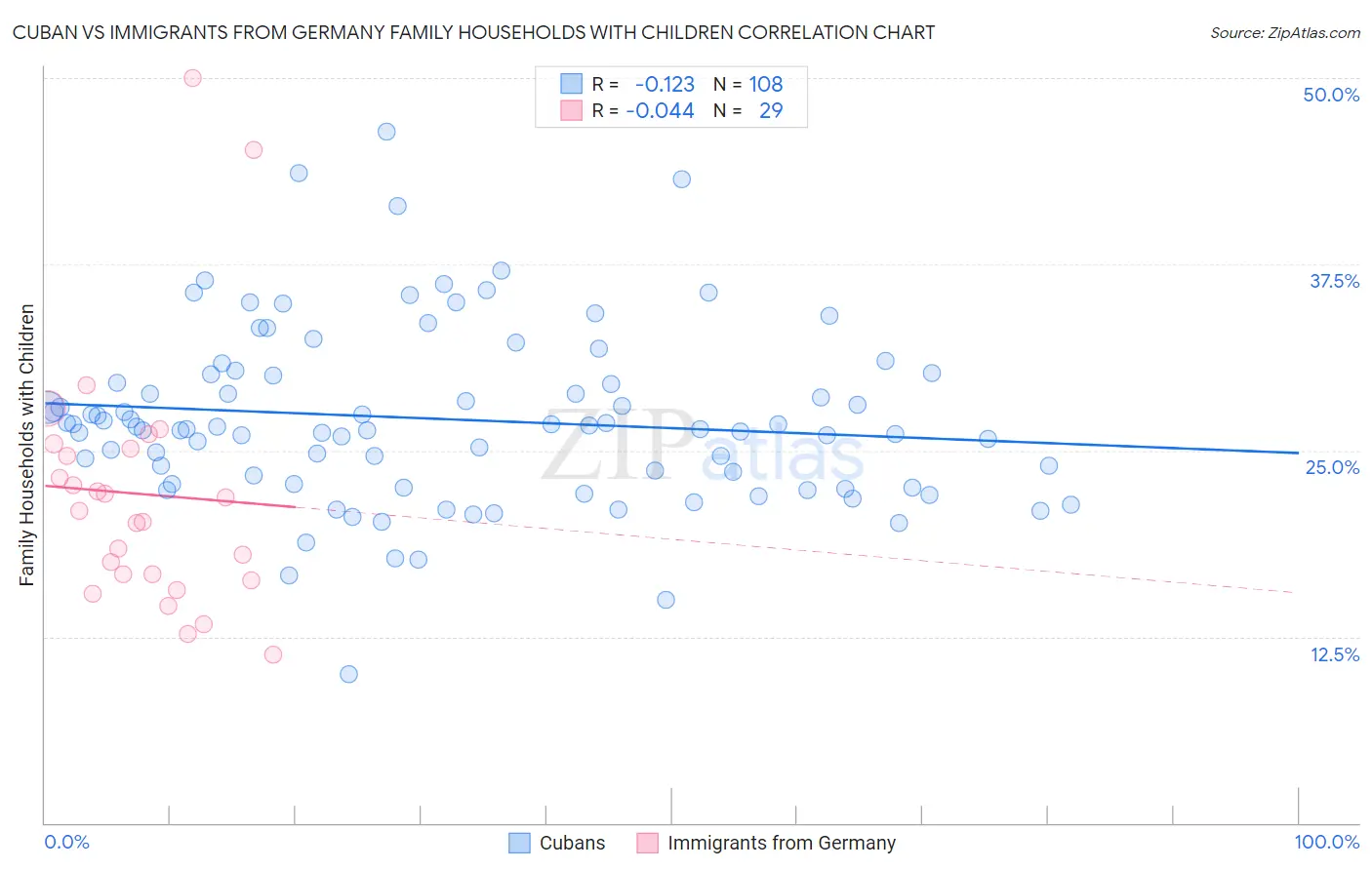Cuban vs Immigrants from Germany Family Households with Children
COMPARE
Cuban
Immigrants from Germany
Family Households with Children
Family Households with Children Comparison
Cubans
Immigrants from Germany
27.1%
FAMILY HOUSEHOLDS WITH CHILDREN
12.2/ 100
METRIC RATING
216th/ 347
METRIC RANK
27.0%
FAMILY HOUSEHOLDS WITH CHILDREN
4.4/ 100
METRIC RATING
234th/ 347
METRIC RANK
Cuban vs Immigrants from Germany Family Households with Children Correlation Chart
The statistical analysis conducted on geographies consisting of 448,752,721 people shows a poor negative correlation between the proportion of Cubans and percentage of family households with children in the United States with a correlation coefficient (R) of -0.123 and weighted average of 27.1%. Similarly, the statistical analysis conducted on geographies consisting of 463,563,782 people shows no correlation between the proportion of Immigrants from Germany and percentage of family households with children in the United States with a correlation coefficient (R) of -0.044 and weighted average of 27.0%, a difference of 0.61%.

Family Households with Children Correlation Summary
| Measurement | Cuban | Immigrants from Germany |
| Minimum | 10.0% | 11.3% |
| Maximum | 46.4% | 50.0% |
| Range | 36.4% | 38.7% |
| Mean | 27.1% | 22.1% |
| Median | 26.5% | 21.0% |
| Interquartile 25% (IQ1) | 22.8% | 16.5% |
| Interquartile 75% (IQ3) | 30.1% | 25.3% |
| Interquartile Range (IQR) | 7.3% | 8.8% |
| Standard Deviation (Sample) | 6.0% | 8.5% |
| Standard Deviation (Population) | 6.0% | 8.4% |
Demographics Similar to Cubans and Immigrants from Germany by Family Households with Children
In terms of family households with children, the demographic groups most similar to Cubans are U.S. Virgin Islander (27.1%, a difference of 0.0%), Northern European (27.2%, a difference of 0.030%), Greek (27.1%, a difference of 0.040%), Immigrants from Japan (27.1%, a difference of 0.080%), and Austrian (27.1%, a difference of 0.13%). Similarly, the demographic groups most similar to Immigrants from Germany are Immigrants from Morocco (27.0%, a difference of 0.040%), Yugoslavian (27.0%, a difference of 0.080%), Immigrants from Italy (27.0%, a difference of 0.080%), Luxembourger (27.0%, a difference of 0.13%), and Bulgarian (27.0%, a difference of 0.15%).
| Demographics | Rating | Rank | Family Households with Children |
| Northern Europeans | 12.8 /100 | #215 | Poor 27.2% |
| Cubans | 12.2 /100 | #216 | Poor 27.1% |
| U.S. Virgin Islanders | 12.1 /100 | #217 | Poor 27.1% |
| Greeks | 11.4 /100 | #218 | Poor 27.1% |
| Immigrants | Japan | 10.7 /100 | #219 | Poor 27.1% |
| Austrians | 9.9 /100 | #220 | Tragic 27.1% |
| New Zealanders | 9.6 /100 | #221 | Tragic 27.1% |
| Paraguayans | 9.4 /100 | #222 | Tragic 27.1% |
| Pima | 9.2 /100 | #223 | Tragic 27.1% |
| Germans | 8.7 /100 | #224 | Tragic 27.1% |
| Canadians | 7.5 /100 | #225 | Tragic 27.1% |
| Czechoslovakians | 6.6 /100 | #226 | Tragic 27.0% |
| Tsimshian | 6.6 /100 | #227 | Tragic 27.0% |
| Scottish | 6.5 /100 | #228 | Tragic 27.0% |
| Immigrants | Caribbean | 6.3 /100 | #229 | Tragic 27.0% |
| Bulgarians | 5.8 /100 | #230 | Tragic 27.0% |
| Luxembourgers | 5.5 /100 | #231 | Tragic 27.0% |
| Yugoslavians | 5.1 /100 | #232 | Tragic 27.0% |
| Immigrants | Italy | 5.0 /100 | #233 | Tragic 27.0% |
| Immigrants | Germany | 4.4 /100 | #234 | Tragic 27.0% |
| Immigrants | Morocco | 4.2 /100 | #235 | Tragic 27.0% |